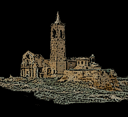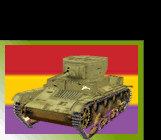 |
 |
|

|
|
|
OtherCarrol Ligero EuzkadiThis small tank represents one of the few domestic ventures into
armoured production, mostly out of necessity since the Basque front,
isolated by the Nationalists from the rest of Spain, received little
of the material support coming out of the Soviet Union. This small
tank had a mass of 4.5 metric tons and mounted armour varying in
thickness from 6-10 mm. With a crew of four, armament varied, probably
being small automatic weapons which could be fired out of the four
radiating ports on the turret which gave it 360 degrees of coverage.
The engine was air cooled with armoured vents at the rear of the
vehicle and was prone to mechanical breakdown. Carro“Sadurni de Noya”The Catalonian “Sadurni de Noya” was one of the few attempts at domestic AFV production during the Spanish civil strife. Lacking in Soviet AFV’s due to Madrid’s suspicious jealously of Catalan autonomy, Catalonians resorted to using some of their industrial potential in the production of an armoured car that was produced in two versions: one as an unarmed personnel carrier; and the other as an assault vehicle mounting a light machine gun. Well crafted with a number of design innovations, the Sadurni de Noya was mechanically reliable but was too insignificantly armed to make any impact on the battlefield. A number of these vehicles were then relegated to use as transport or as artillery tractors. The Spanish designation for this vehicle was Carro “Sadurni de Noya.” M28 Police Armoured CarMounting a Hotchkiss machine gun, these 8 ton vehicles were designed for crowd control and intimidation by the paramilitary police before the war. They were utilized in the early fighting for the cities, such as Madrid and Barcelona and found no prominent use thereafter, either being returned to security duty or lost as a prize amongst various militias. They could travel up to 45km/hr or 40 km/hr in reverse, carried either four machine guns or one 37mm gun and one machine gun and had armour of up to 12mm thickness. Spanish designation for this car is Auto Blindado de la Policia. Armoured Truck "type A"This truck is representative of various vehicles that were utilized by Republican militia early in the war. Varying between 1.5 to 2.6 plus metric tons, these trucks were modified to carry a fabricated armoured superstructure designed to protect the driver and occupants. Typical armour thickness varied between 4 to 12 mm and consisted of metal plates bolted or welded in place. Armament consisted of a typical crew of 8-13 riflemen firing out of ports or slits in the side of truck bed, protected by an armoured housing. Typical engines were 4-6 cylinders and with the added weight of men and armour, these trucks were not capable of any great speed. Of dubious worth, a number of these vehicles made their appearance in the war, mostly in Andalucia and in the isolated northern provinces of Republican Spain. Their intended purpose was to add offensive weight in street fighting, but due to the several weak point in the armour, they tended to fill a more defensive roll. Spanish designation for an armoured truck was Camión blindado. Armoured Truck "type B"This type of armoured truck varied from the type A by adding machine gun armament in the form of two light machine guns mounted to fire to either side. Though only one such vehicle was constructed for use in Seville, this type of truck was similar to a number of Catalonian models. Armoured Truck "type C"This type of armoured truck followed the pattern for the type B but added a Hotchkiss 8mm machine gun to fire in a forward arc, supplementing the fire of the 5-8 rifles that fired from either side. Typically crewed by 18-20 men (for game purposes, one militia squad, 1 crew, and one militia leader), Type C trucks had armour varying between 6-12mm, the thicker armour being placed around the truck bed. The top of the Type C trucks were, as was typical of Spanish armoured trucks, more thinly armoured, with plates of 2-3mm in thickness. An unknown quantity of this type of vehicle were constructed and some were known to have been used in the defense of Madrid. Armoured Truck "type E"This armoured truck is a composite that represents vehicles used by the Catalonians in their Huesca offensive and those of the Basques and other Northeners in the defense of their lands. Their common feature was the use of an 8mm Hotchkiss machine gun mounted in a revolving turret on the top of the truck along with the secondary armament provided by up to 6-16 rifles with viewports mostly to the sides. Usually mounting 12mm armour, this type of truck was a common feature of early battles in Catalonia and the North. Crew varied between 11-20 men. Armoured Truck "type F"This type of armoured truck mounted two Hotchkiss machine guns to either side, sometimes supplemented by riflemen. Better constructed than other armoured trucks, this type was actually used off road in irregular terrain and was capable of speeds up to 62 km/hr. Trucks of this type were used in the North in Asturias and in the Battle for Teruel. Armour varied between 8-12 mm while crew size varied based on type, from 6-13 men. Tractor Oruga Blindado TOB N. 1Only one of these vehicles was built and it was used in combat by Republican forces in Andalucia early in the war. Covered by light armour of 6-8mm, this armoured tractor was designed to be able to negotiate rough terrain. For armament it carried either a light machine gun or automatic rifle to be fired from ports. It was crewed by 4 or 5 men. Spanish designation for this vehicle was Tractor Oruga Blindado N.1. Armoured TrainA carry over from tactics used successfully in the Soviet Civil
War, the armoured train was used to less practical effect in the
Spanish War as a mobile firing platform by Republican forces. Actual
trains varied so the version given here is meant as a representation
only.
TrucksA wide variety of trucks existed in Spain prior to the war, of domestic, American, French and English manufacture, most of which were pressed into service by both sides desperate to mobilize their forces. After the intervention of foreign powers, Soviet and some French trucks passed into Republican hands while Italy and Germany provided vehicles to their Nationalist progeny. Also, due to the sympathies of some American industrialists to the Nationalist cause, General Franco was able to purchase American trucks and oil on credit. Captured vehicles were readily pressed into service by both sides.
|
|
